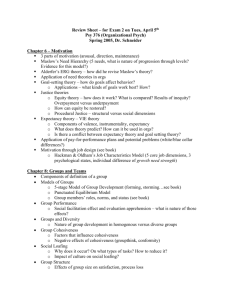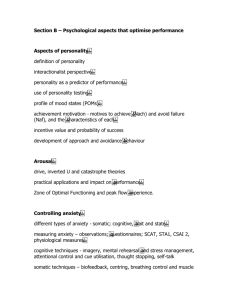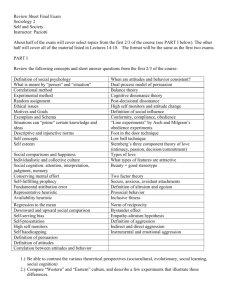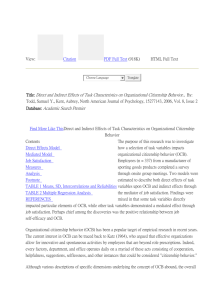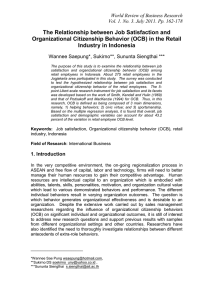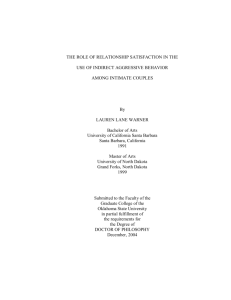Review Sheet – Exam 2 - the Department of Psychology at Illinois
advertisement
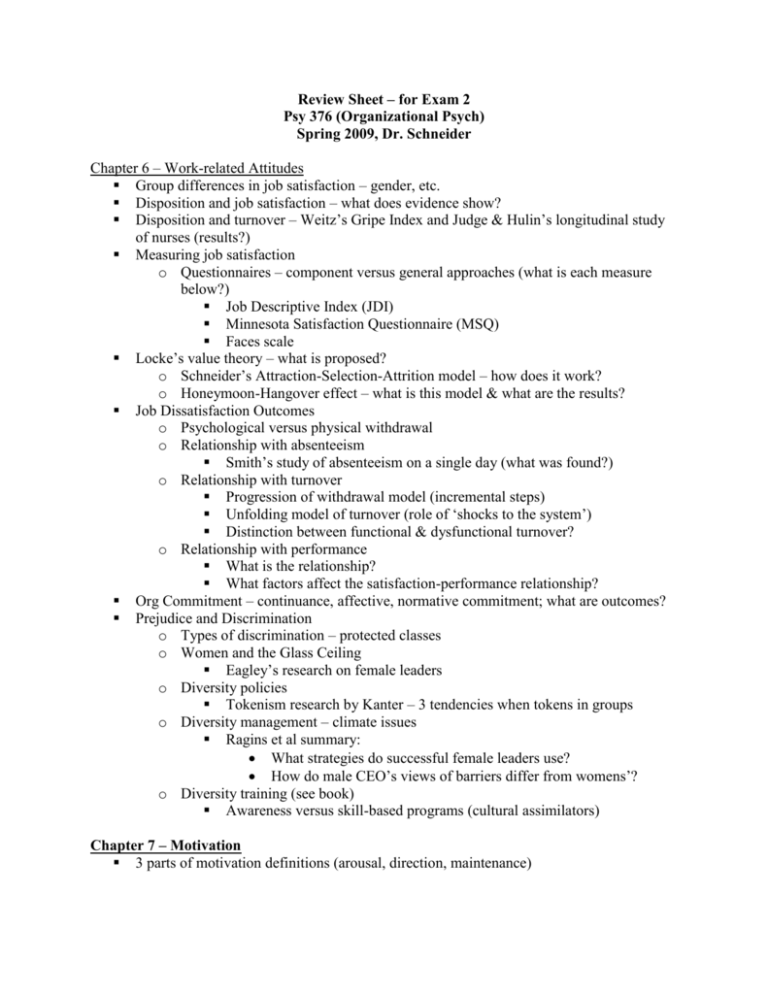
Review Sheet – for Exam 2 Psy 376 (Organizational Psych) Spring 2009, Dr. Schneider Chapter 6 – Work-related Attitudes Group differences in job satisfaction – gender, etc. Disposition and job satisfaction – what does evidence show? Disposition and turnover – Weitz’s Gripe Index and Judge & Hulin’s longitudinal study of nurses (results?) Measuring job satisfaction o Questionnaires – component versus general approaches (what is each measure below?) Job Descriptive Index (JDI) Minnesota Satisfaction Questionnaire (MSQ) Faces scale Locke’s value theory – what is proposed? o Schneider’s Attraction-Selection-Attrition model – how does it work? o Honeymoon-Hangover effect – what is this model & what are the results? Job Dissatisfaction Outcomes o Psychological versus physical withdrawal o Relationship with absenteeism Smith’s study of absenteeism on a single day (what was found?) o Relationship with turnover Progression of withdrawal model (incremental steps) Unfolding model of turnover (role of ‘shocks to the system’) Distinction between functional & dysfunctional turnover? o Relationship with performance What is the relationship? What factors affect the satisfaction-performance relationship? Org Commitment – continuance, affective, normative commitment; what are outcomes? Prejudice and Discrimination o Types of discrimination – protected classes o Women and the Glass Ceiling Eagley’s research on female leaders o Diversity policies Tokenism research by Kanter – 3 tendencies when tokens in groups o Diversity management – climate issues Ragins et al summary: What strategies do successful female leaders use? How do male CEO’s views of barriers differ from womens’? o Diversity training (see book) Awareness versus skill-based programs (cultural assimilators) Chapter 7 – Motivation 3 parts of motivation definitions (arousal, direction, maintenance) Maslow’s Need Hierarchy (5 needs, what is nature of progression through levels? Evidence for this model?) Alderfer’s ERG theory – how did he revise Maslow’s theory? o How are need theories used in organizations? Goal-setting theory – how do goals affect behavior? o Applications – what kinds of goals work best? How? o Vertical vs. horizontal stretch goals (see book) o Importance of power distance in involvement in goal setting – cultural differences o Example of Toyota’s customer service survey – linking goals & rewards Equity theory – o Inputs: Outcomes ratio – when is equity perceived? How does motivation occur? o Differences in ratios for under- and over-payment o What are some options for restoring equity? Expectancy theory – VIE theory o Components of valence, instrumentality, expectancy – know definitions o What does theory predict? How can it be used in orgs? o Criticisms of VIE theory? o What is the nature of the conflict between expectancy theory and goal setting theory? What was the resolution? Job Redesign o Job Enrichment vs. job enlargement – differences? o Hackman & Oldham’s Job Characteristics Model – job dimensions & growth need strength influence motivation Application of pay-for-performance and merit pay plans and potential problems (white/blue collar differences?) Chapter 11 – Prosocial and Deviant Behavior o Transactional vs. relational psychological contracts – what are they? How might there be generational differences? What type of contract violation is worse? o Org Citizenship Behaviors o 5 categories of behaviors – know examples of each o What influences OCB? o Whistleblowing can be viewed as OCB – see book (retaliation, etc.) Also suggestions of selfish motives related to whistleblowing o Conflict o Integration versus distribution dimensions (win-win versus win-lose orientations) o Ruble and Thomas model – 5 styles of conflict management (how do they relate to integration and distribution?) o Culture, Gender, and Conflict – how do individualism-collectivism affect conflict? Gender and cultural preferences for conflict management? o Conflict Management o Bargaining zone model – initial point, target point, resistance point o Stevens et al (’93) study on gender and salary negotiation – what were the results? o 3rd party interventions – types of arbitration and mediation (and differences betw them) o Conventional v. final offer arbitration o Deviant Org Behavior o Workplace violence and aggression – what is common? Impact of procedural justice? o How can aggression be managed through selection? Example of integrity testing – Hogan Personality Inventory What personality dimensions are used in the HPI to assess aggression? Validation of the HPI / Integrity tests o Glomb aggression study – to what do employees attribute aggression? o Video on Larry Jasion (postal worker); escalation of aggression issue Chapter 12 – Power and its Abuses o Definitions of influence, power, politics – differences between them o Types of Power – French and Raven (position versus personal power and types within them) o Structural Factors of Power – 2 models o Resource Dependency Model – who is predicted to have power? o Strategic Contingencies Model – who is predicted to have power? o Power and Politics o What conditions lead to political behavior? o What are the negative effects of political behavior? o Ferris et al study (reviewed in class) o How can perceptions of politics be viewed as stressor? o What are antecedents, outcomes, moderators of politics specified in their model? o What were the results? Chapter 8: Groups and Teams Components of definition of a group Models of Groups o 5-stage Model of Group Development (forming, storming…see book) o Punctuated Equilibrium Model Group Performance o Social facilitation effect and evaluation apprehension – what is nature of those effects? Groups and Diversity o Nature of group development in homogenous versus diverse groups Social Loafing o Why does it occur? On what types of tasks? How to reduce it? o Impact of culture on social loafing? Group Decision Techniques o Nominal group technique – how does it work? o Delphi technique – how does it work? Group Structure o Effects of group size on satisfaction, process loss o Performance and Task Type – additive, disjunctive, conjunctive tasks (definitions and how they relate to group performance) Research issues in studying groups – what kinds of things make it difficult to study work groups? Teams o Differences between definitions of teams versus groups Types of teams o Cross-functional teams, problem solving teams, etc. Team Building – what is commonly done? How does it work? Is it effective? How to measure ‘team effectiveness” - what are some different options? Review Campion & Stevens research described in class notes Virtual Teams –Electronic brainstorming – advantages/disadvantages? Boeing study on its effectiveness Flight Crews as teams – what does Foushee’s research indicate? How do team principles apply here? What types of flight crews work best together?
